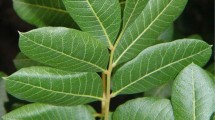Abstract
Medicinal plants described in the Indian “Ayurvedic” literature viz. Tulsi (Ocimum sanctum), Gulvel (Tinospora cardifolia), bitter Neem (Azadirachta indica), Kanher (Nerium Åndicum), Vekhand (Acorus calamus), and Peacock's feather (ash) were analyzed for minor and trace elements by instrumental neutron activation analysis. The samples and the standards from the National Institute of Standards and Technology, USA and IAEA, Vienna were irradiated for 5 min, 1 h, 5 h, and 10 h with thermal neutrons at a flux of 1012–1013 n cm−2s−1 in APSARA and CIRUS reactor at BARC Bombay. High resolution γ ray spectrometry was performed using a 45 cm3 HPGe detector and a 4096 MCA system. Concentrations of 13 elements were determined. Zinc, manganese, and sodium were significantly higher in Tulsi leaves while zinc is higher in Neem leaves. Peacock's feathers were found to be rich in manganese, iron, copper, and zinc. A high concentration of mercury was also found in the peacock's feather ash. The therapeutic significance in restoring ionic balance is discussed.
Similar content being viewed by others
References
N. G. Patel, Ayurveda: The Traditional Medicine of India inFolk Medicine, The Art and Science, Chapter 3, R. P. Steiner, ed., American Chemical Society, Washington DC, p 41 (1986).
S. N. Parchure,Charak Samhita, vol. 1–13, Sagar publications, Pune, India (1983).
A. V. Yadav,Dravyaguna, Part I & II, Baidyanath Publications, Calcutta, pp. 794 (1980).
B. Mukerji,The Indian Pharmaceuticals Codex, Indigenous Drugs, vol. 1 Council of Scientific and Industrial Research, New Delhi, pp. 352 (1958).
C. R. Bhandari,Vanoshadhi Chandrodaya, vol. 8, The Time Table Press, Banaras, India, pp. 1666 (1925).
K. S. Chen, C. L. Tseng, and T. H. Lin, Trace elements in natural drugs determined by INAA,J. Radioanal Nucl. Chem. 170, 265–280 (1993).
G. P. Garg, S. K. Nigam, and C. W. Ogle, The gastric antiulcer effects of the leaves of the neem tree,Planta Med. 59, 215–217 (1993).
S. S. Riar, C. Devkumar, R. C. Sawney, G. Ilavazhagan, J. Bardhan, A. K. Kain, P. Thomas, R. Singh, B. Singh, and R. Parshad, Antifertility activity of volatile fraction of neem oil,Contraception 44, 319–326 (1991).
E. B. Thompson, and C. C. Anderson, Cardiovascular effects of Azadirecta indica extract,J. Pharm. Sci. 67, 1476–1478 (1978).
Chemical and Engineering News (ACS, USA) Science and Technology Department, Natural product may be Alzheimer's therapeutic.71, 35–36 (1993).
A. S. Prasad, ed., Zinc and Copper, inTrace Elements in Human Health and Disease vol. 1, Academic, New York (1976).
P. U. Rao, Chemical composition and biological evaluation of debittered and defatted neem (Azadirachta indica) seed kernel cake.J. Am. Oil Chem. Soc. 64, 1348–1351 (1987).
N. S. Rajurkar and M. S. Winchurkar, Instrumental neutron activation analysis of some Ayurvedic medicines,Appl. Radiat. Isot. 43, 1515–1516 (1992).
M. K. Wong, P. Tan, and Y. C. Wee, Heavy metals in some Chinese herbal plants,Biol. Trace Elem. Res. 36, 135–142 (1993).
C. L. Ndiokwere, Determination of constituent elements in some Nigerian medicinal plants by thermal neutron activation analysis,J. Radioanal Nucl. Chem. Lett.,85, 325–338 (1984).
G. D. Kanias and A. Loukis, Determination and correlation of active constituents and trace elements in the medicinal plant Thymus capitatus Hoffm. and Link, Frezenius Z,Anal. Chem. 327, 355–357 (1987).
N. K. Mumba, Determination of Mg, Al, Si, Cl and K in some medicinal plants by NAA and REA methods, J. Csikal and G. Peto,Radiochem. Radioanal. Lett. 52, 372–382 (1982).
S. Amiel, ed.Nondestructive Activation Analysis with Nuclear Reactors and Radioactive Neutron Sources: Studies in Analytical Chemistry, vol. 3, Elsevier, Amsterdam, pp. 369 (1981).
H. K. Wankhade, D. L. Samudralwar, and A. N. Garg, Neutron activation analysis of geological and biological samples using short term reactor irradiation and successive counting,J. Radioanal. Nucl. Chem. Lett. 105, 95–106 (1986).
R. G. Weginwar, D. L. Samudralwar, and A. N. Garg, Determination of P in biological samples by thermal neutron activation followed by β− counting,J. Radioanal. Nucl. Chem. Articles 133, 317–324 (1989).
National Institute of Standards and Technology (NIST), Spinach Certificate of Analysis 1979.
L. Psonicki and A. N. Hanna, Report on intercomparison IAEA/V-10 of the determination of trace elements in Hay Powder, IAEA, Vienna (1985).
H. J. M. Bowen, Kale as a Reference Material inBiological Reference Materials: Availability, Uses and Need for Validation of Nutrient Measurement, W. R. Wolf, ed., John Wiley, New York, (1985) 3–18.
D. L. Samudralwar, H. K., Wankhade, and A. N. Garg, Multielemental analysis of IAEA intercomparison standard Hay Powder V-10 and some edible plant leaves by INAA,J. Radioanal. Nucl. Chem. Articles 116, 307–315 (1987).
A. Kabata-Pendias and H. Pendias,Trace Elements in Soils and Plants, CRC, Boca Raton, FL, pp. 315 (1991).
R. R. Chattopadhyay, S. K. Sarkar, S. Ganguly, C. Medda, and T. K. Basu, Hepatoprotective activity of acimum-sanctum leaf extract against paracetamol induced hepatic damage in rats,Indian J. Pharmacol. 24, 163–165 (1992).
S. Khanna, S. R. Gupta, and J. K. Grover, Effect of long term feeding of tulsi ocimum sanctum on reproductive performance of adult albino rats,Indian J. Exptl. Biol. 24, 302–304 (1986).
R. J. P. Williams, The biochemistry of zinc,Polyhedron 6, 61–70 (1987).
V. K. Patel and B. H. Venkatakrishna, Folklore therapeutic indigenious plants in periodontal disorders in India (review, experimental and clinical approach),Int. J. Clin. Pharmacol. Ther. Toxicol. 26, 176–184 (1988).
O. K. Osubiojo, Multielement analysis of Nigerian chewing sticks by instrumental neutron activation analysis, V. P. Guinn and A. Okunuga,J. Radioanal. Chem. 74, 149–156 (1982).
R. Puls,Mineral Levels in Animal Health, 2nd ed., Sherpa International, Canada, pp. 356 (1994).
Author information
Authors and Affiliations
Rights and permissions
About this article
Cite this article
Samudralwar, D.L., Garg, A.N. Minor and trace elemental determination in the Indian herbal and other medicinal preparations. Biol Trace Elem Res 54, 113–121 (1996). https://doi.org/10.1007/BF02786258
Received:
Accepted:
Issue Date:
DOI: https://doi.org/10.1007/BF02786258




